Call Us
+86 136 6007 9809
Call Us
+86 136 6007 9809
Jun. 20, 2023
New energy vehicles are unique, and their range on the lightweight body demand is increasingly high. Some models use lightweight aluminum alloy, magnesium alloy, high-strength steel, structural steel, engineering plastics, carbon fiber composites, and other mixed materials synergistic processing; this new processing technology limits the application of some traditional welding technology.
The riveting + arc welding process shows advanced manufacturing capabilities and simultaneously improves product performance and quality; cost control is also more advantageous.
Engine compartment area: As can be seen from the figure below, a large number of screw connections are applied in the front compartment area, and the screw connections are divided into four structural forms, namely bolt + nut, bolt + compression rivet / blind rivet nuts, bolt plus nut plate, bolt plus internal thread sleeve structural form, mainly according to the structure and connection strength to choose. In the front frame, the application of riveting can be seen through rivets to achieve the connection between the bracket and the profile; the process does not require positioning fixtures, and for the strength requirements to be exceptionally high, parts are a good choice. Cabin front frame riveting details, Rear frame screwing details, subframe connection details (subframe is a few aluminum tubes welded into the frame, feeling a little weak strength, but in the connection is seen in the use of stronger bolts), a breakthrough in lightweight, the body frame structure relative to the same level of models to achieve a lighter and more straightforward.
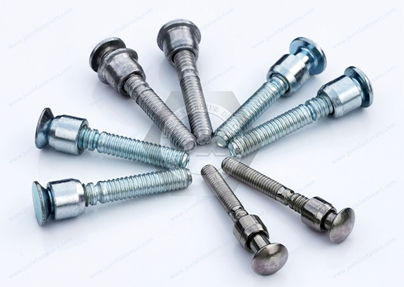 | 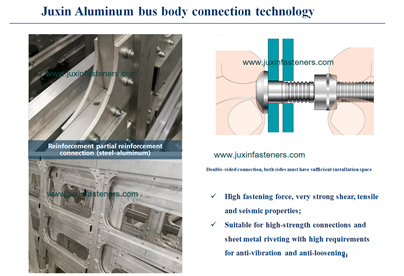 | 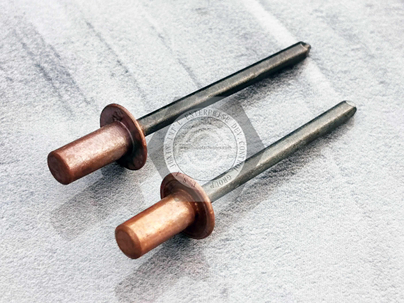 |
The internal composition of the new energy battery board
The internal constituent of the new energy battery panel constitutes a new energy vehicle power battery board with multiple combined battery modules.
1. The battery tray, liquid cooling, heat dissipation system, and flame retardant insulation protection layer encapsulate it. Installation
2. Battery core module installation,
3. Water-cooled system gas tightness test.
4. High and low-pressure wire beam installation,
5. high-voltage insulation test.
6. Installation of flame retardant heat insulation protective layers to further reduce the risk of heat control.
7. Installation of the upper cover
8. PACK gas-tight detection.
9. EOL offline testing, the internal structure, and production assembly of the battery are inseparable from high-intensity bolt&screws connection effects. The surface treatment of electroplating nickel alloy neutral salt fog test has no red rust after 720 hours, limited to high-pulling blind rivet nuts, brass insert nuts, and Self-clinching nuts.
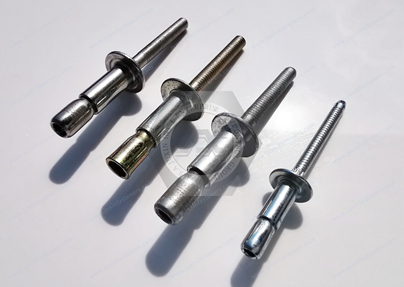 | 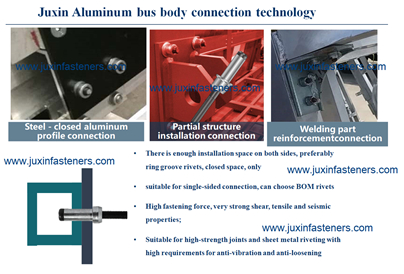 | 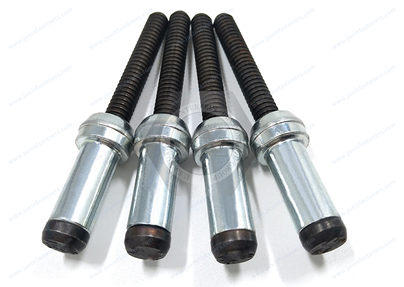 |
The assembly process of the new energy vehicle PACK is somewhat similar to the engine assembly process of traditional fuel vehicles. The five systems are connected by high-strength bolts, bolts and nuts, Automotive Seat Parts, Automotive Door Shaft Parts, cable ties, wire clips, harness rivets, and rivet nuts to form an assembly. The power battery pack is generally installed under the seat of the new energy vehicle or the trunk and is in direct contact with the outside world. The battery pack must be well sealed when a new energy vehicle is wading in the water.
Electric vehicles have also made a series of advances in battery components, usually using components made of PA 66, and now gradually using PA 6 directly—a system including a cover and charger. Nylon rivets are used as automotive, industrial, solar, electrical, and electrical connectors. In pure electric vehicles, the long-term thermal resistance of polyamide six compounds to water-glycol mixtures is sufficient for most components, even in some cases for longer stress times; metal screws, Nuts, or nylon rivets screw the cap along with the seal to the charger's aluminum housing. The PA 6 compound has high strength and rigidity, ensuring the cover meets the strict sealing requirements. Suppose metal materials are considered for the side plate of the energy battery. In that case, it can provide more stable installation strength after being fixed with bolts, providing more stability under complex working conditions. It can still guarantee a stable connection.
Electric vehicle power battery structure system mainly consists of a battery PACK top cover, tray, various metal brackets, end plates, and bolts. High-strength straighter long flange bolts used primarily in buses, logistics, and vehicles battery PACK and new energy vehicles are characterized by a unique process of heat treatment, straighter treatment, and higher verticality requirements while strengthening the de-hydrogenation process. The use is multi-station extended cold heading parts forming machine production, one-time molding; in meeting the extra-long bolts, extended flange face bolts can reach 8.8 and 10.9 grade; at the same time, we have some control over the verticality of the extra-long screws; new energy electric vehicle industry is characterized by continuous improvement in reliability, speed, and punctuality to market. We understand these trends and the resulting challenges and provide components that meet high safety and quality standards.
With the gradual development of the power battery industry, the battery PACK modular technology will become increasingly mature. To improve the integration efficiency of the Pack, there are two feasible ways: one is to optimize the internal structure of the PACK design, significantly reduce the number of components inside the PACK, and more elements and functions integrated into the module and box, thereby reducing weight; the other is to use lightweight materials, such as the use of aluminum or composite materials instead of high-strength steel, the module using plastic parts (such as JX-R3035B JX-R3035B, JX-R3545B, JX-3535B, JX-R4070B, and other nylon rivets, Snap-in, screw-mount & adhesive supports; spacers & stand-offs, Vertical, horizontal & tensioning PC board rack card guides; pullers & ejectors, Snap-in, push, blind hole & unscrewing rivets; plastic screws, nuts & washers) instead of metal parts, etc., can also reduce the weight.
1. Power battery holder
The power battery holder requires flame retardant, dimensional stability, chemical resistance, and high strength, mainly using modified PPE, PPS, PC/ABS, etc.
2. Power battery cover
A power battery cover requires flame retardant, dimensional stability, chemical resistance, and high strength. It is currently mainly using modified PPS, PA6, PA66, etc.
3. Power battery case
The power battery case requires flame retardant, dimensional stability, chemical resistance, and high strength. It is mainly mainly using modified PPS, PPP, PPO, etc. We have continuously introduced new products and improved the performance of established lines. Juxin Enterprise offers complimentary application engineering support. We will assist with new designs as well as help resolve issues, and recommend cost savings on existing designs
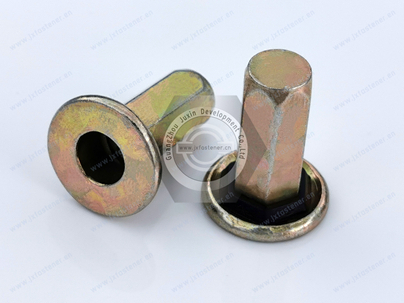 | 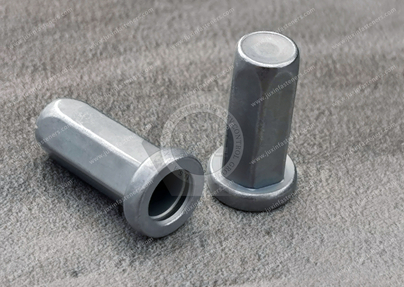 | 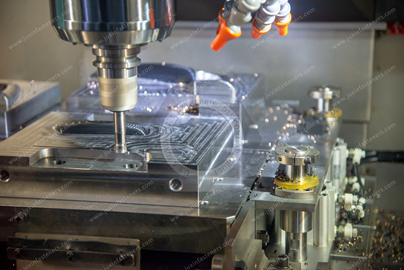 |
Double-stacked washers, PACK battery assembly locking aids
Lock washers are also known as lock washers, self-locking washers, DIN25201 lock washers, double-stack lock washers, etc. Working method: The new washer is composed of two pieces. Its unique embedded structure changes how the traditional washer mainly achieves anti-looseness through friction and uses the tension between the two gaskets to achieve the dual effect of anti-looseness and tightening. , Material and surface treatment: SUS304.316.630 (A2.A4) stainless steel or carbon steel SK5.SK7 and customer-specified European special steel [(EN 1.7182 (27MnCrB5) EN 1.5528 (22MnB5) (1.4462, DIN X2Gr-NiMoN2253] equivalent) The surface treatment of carbon steel such as alloy steel is usually treated with zinc-magnesium Tedacromet coating. The neutral salt spray test proves it can withstand at least 720 hours. At the same time, all stainless steel products can be hardened according to requirements (HV350-550 ) to enhance and improve mechanical properties.
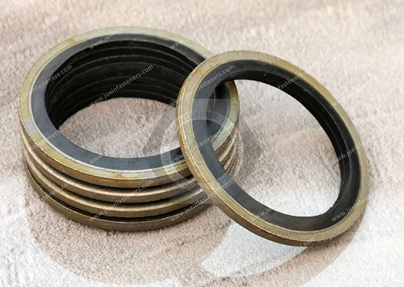 | 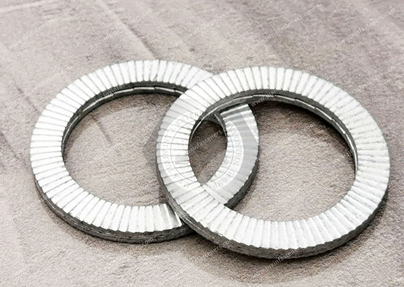 | 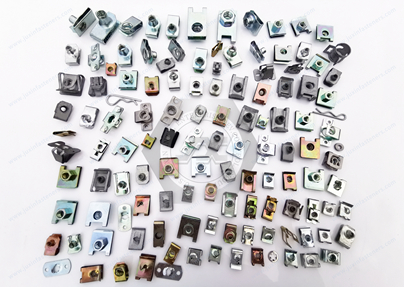 |
Aluminum alloy battery pack shell structure
Typical aluminum alloy welded battery pack shell. The shell mainly comprises an aluminum alloy profile frame and an aluminum alloy profile base plate, which is welded by a 6-series extrusion profile. To ensure the welding strength and sealing, stir friction fusing with low-stress deformation is selected. The standard parts applicable to the aluminum alloy profile are generally steel wire screw sleeves, blind rivet nuts, and self-clinching nuts. In addition to the common parts, the rest is 100% aluminum alloy material. The shell has high strength, is lightweight, and has good corrosion resistance. The main connection methods of aluminum alloy battery pack shells are stir friction welding, MIG, blind rivet nuts, self-clinching nuts, and a small amount of arc welding and gluing. Usually, the battery pack sealing protection level is required to reach IP67 to ensure that the Pack is sealed and waterproof so that the battery pack will not be short-circuited due to water ingress. If the bezel is arc-welded to the inside of the base plate, it needs to be coated with weld sealant to ensure the seal. However, the standard parts of the connection itself must also provide its sealing, and the case flange generally uses M5 & M6 thickness head blind rivet nuts and Open-end hexagon thickness blind rivet nuts. Juxin has produced blind rivet nuts with an adhesive surface that can be specially used for waterproof battery pack sealing. The blind rivet nut used at the front end is not treated separately because it has a specific sealing effect, and the external attachment also has a seal. If leakage is found, glue coating treatment can be done.
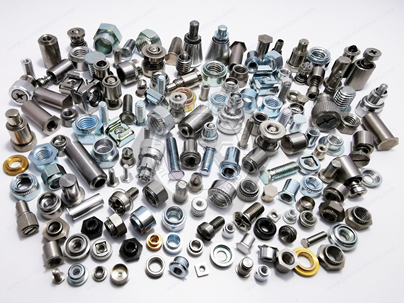 | 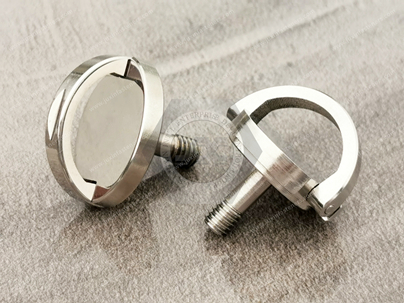 | 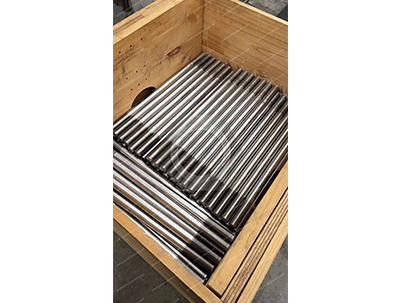 |
New Type of Fastening Connections for Aluminum Body
Aluminum has significantly contributed to lightweight and fuel economy and is increasingly used in automotive bodies. Many types of fasteners for aluminum applications can be divided into two categories based on the material, steel and aluminum, and into two categories based on the connection type: cold and hot connections. There are four types of riveting: compression, tension, lock, and flange riveting.
Compression Riveting: This is a standard form of connection that interlocks with the sheet metal through a legal or radial structure. There are two types of linking: serrated interlocking and flange interlocking. It can be widely used in stamping, extruding, and casting aluminum alloy body parts and is mainly divided into compression riveting nuts and bolts.
Tension Riveting: Tension riveting uses standard component heads to pull, deform, expand, and clamp the opening of the sheet metal to form a stable and reliable standard connection. Tension riveting is mainly divided into tension riveting nuts and bolts and pull-rivet pins (which especially achieve the connection of multiple parts, while tension riveting nuts and bolts primarily serve as connection assistance).
Lock Riveting (SPR, TOX): Lock riveting is divided into SPR and TOX. SPR connects parts directly through rivets, while TOX interlocks parts with each other. When the upper and lower dies squeeze the rivet legs, they flip outwards and form a rivet button while embedded into the sheet metal, thereby firmly connecting the upper and lower plates.
Flange Riveting: Standard components are mainly connected with the sheet metal by folding and interlocking the bottom flange structure of the standard component with the hole plate surface under the action of the pressure head and then extruding and folding the flange into shape to form an interlocking structure, completing the connection of the standard component and the sheet metal. The process includes three stages: fitting, application of force, and molding. This compression riveting common component has a strong pushing force and reliable connection. Still, the structure is complex and expensive, requiring specific lower die matching and shaping. It is generally used for critical hard points or important installation points.
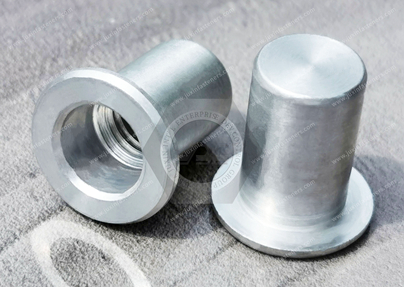 | 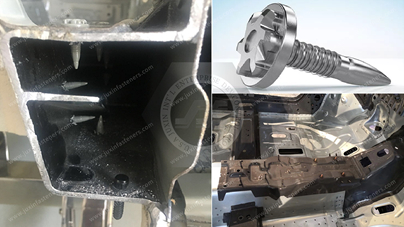 | 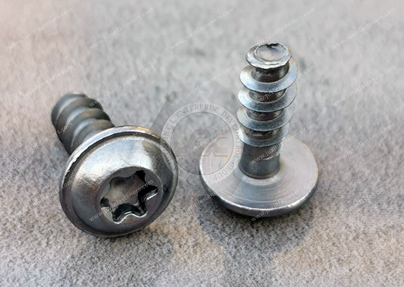 |
What is the standard screwing depth
A. What is the standard screwing depth
The screwing depth standard should generally be between 1.5 times and 1.6 times the outer diameter of the screw thread. When we screw, the screw depth should usually be controlled at 1.5 times to 1.6 times the outside diameter of the screw thread. Still, in practice, the specific screw depth is generally calculated according to 1.5 times and needs to leave a slight margin.
Screw screwing depth is not fixed; the specific need to screw how much generally should depend on the shape and specifications of the screw model; we can also calculate the depth of the screw required according to the screw diameter plus radius, which is widely used in the market screwing skills. If the screw belongs to the M8 cup head screws, then the screw screwing depth should be greater than twelve millimeters; if the screw belongs to the M10 cup head screws, then the screwing depth should be greater than fifteen millimeters.
Second, screwing screws need to pay attention to which aspects
1, in the process of screwing, it is best not to screw all directly into the screw at once; one should first screw into a third. Then the diagonal position of the screw is also screwed into a third so that the items can be balanced, and then according to the same method will be other positions of the screw will also be screwed into a third when all the screws are screwed into a third of the later, you can use a screwdriver to all screws remaining Two-thirds of all the remaining screws into it so that the screws are tightened.
2, the screwing process must be careful, pay attention to their safety, and screwing strength can not be too large or too small; too large is easy to screw the screw, and too small will not be able to screw the screw. If the user is using an electric screwdriver to screw in, then the two should be aligned, and the need to let the electric screwdriver closely rely on the screw head position.
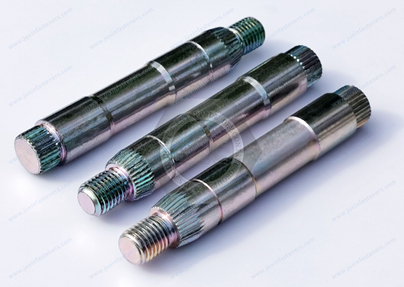 | 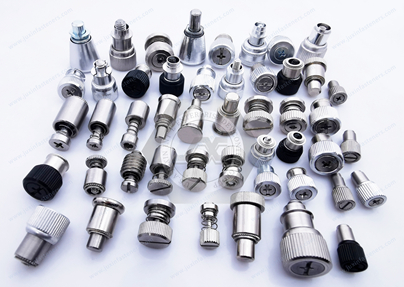 | 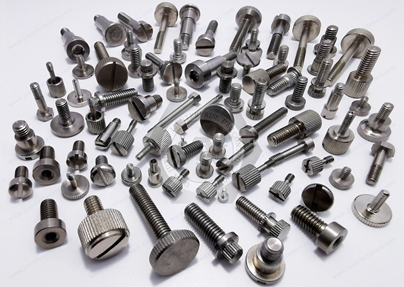 |
What is the role of the pretension of high-strength bolts
Pretension is used to pre-stretch the high-strength bolts, and the pretension of the high-strength bolts is used to compress the connected components to generate static friction to transmit the shear force.
High-strength bolts generally connect the bolt connection of the main components of the building structure. Ordinary bolts can be reused, but high-strength bolts cannot be reused. High-strength bolts are commonly used for permanent connections.
The high-strength bolt connection clamps the plates of the connecting plate through a large tightening pre-pressure in the bolt rod, which is enough to generate a large friction force, thereby improving the integrity and rigidity of the connection. According to different force requirements, it can be divided into two types: high-strength bolt friction connection and high-strength bolt pressure-bearing connection. The essential difference between the two is that the limit state is different.
For high-strength bolts, the nut is tightened with a special wrench so the bolt produces a vast and controlled pretension force, and the pre-stress of the same size is also produced on the connected parts through the nut and the backing plate. Under pre-pressure, a large frictional force will be generated along the surface of the related parts. If the axial force is less than this frictional force, the components will not slip, and the connection will not be damaged. This is the high-strength bolt connection. Principle.
The high-strength bolt connection relies on the friction between the contact surfaces of the connectors to prevent them from sliding each other. To make the contact surfaces have sufficient friction, increasing the clamping force of the components and the friction coefficient of the contact surfaces of the elements is necessary. The clamping force between components is realized by applying pretension to the bolts, so they must be made of high-strength steel, which is why it is called a high-strength bolt connection.
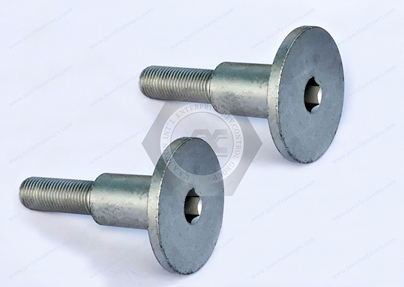 | 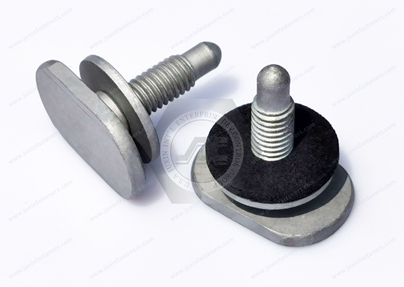 | 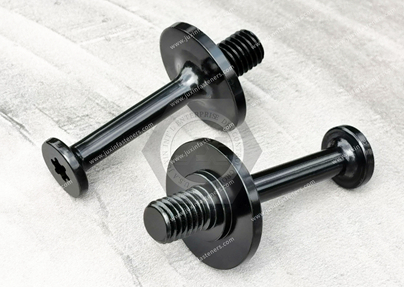 |
Features and applications of threaded fasteners with anti-loosening function
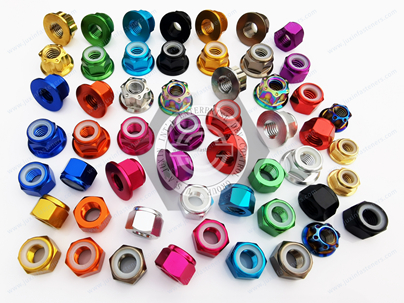 | 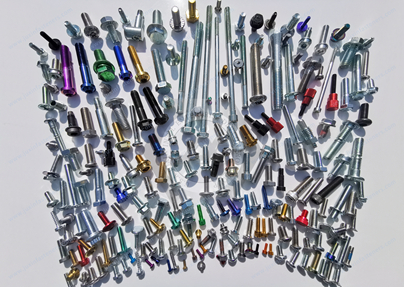 | 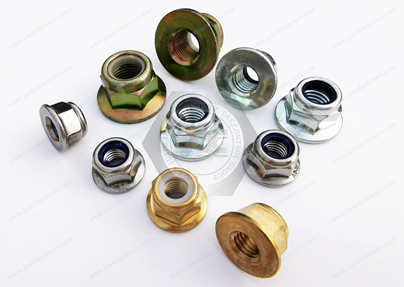 |
① Face bearing hexagonal flange face bolts with teeth
The bearing surface of the bolt is evenly distributed with a specific angle "serrated."
shaped or arc-shaped teeth. In the tightening process, the bearing surface of the pressure force generated by the teeth embedded in the surface of the connector increases the friction of the bolt-bearing surface, thus playing an excellent anti-loosening effect.
(2) Application precautions
① should not be used in combination with flat washers, spring washers;
② should not be used in connection occasions where the hardness of the connected parts is higher than the minimum hardness of the bolt;
③ with the use of nuts, should try to use self-locking nuts;
④ should not be used to connect the appearance of the parts and the texture of the soft parts to be connected.
② Pre-applied anaerobic adhesive bolts/screws
Pre-applied anaerobic adhesive bolts have good anti-vibration and anti-loosening effects. The threads have a specific sealing effect and can be applied under -50~120℃ working conditions.
The adhesive's shelf life is about two years, which makes it easy to store. It is especially suitable for applications with high locking requirements and infrequent disassembly.
2) Application precautions
① When assembling, it should be fastened in place within 10 minutes as far as possible;
② After tightening is completed, no further retightening should be done;
③ When disassembling, try to disassemble after heating if it is possible to use the heating method;
④ When the bolt is used for the second time, clean the threaded hole and apply a small amount of anaerobic adhesive before assembling and tightening.
① ①All-metal lock nut
All-metal lock nuts are mainly hexagon nuts, hexagon flange nuts, twelve-angle flange nuts, etc.
1)Features
When assembled and rotated with the bolt, the deformation amount of the bottom hole of the inner thread or the deformation amount of the thread tooth type interferes with the relationship between the threads, thus increasing the friction force between the threads to achieve the loosening prevention effect.
It is highly reliable in vibration conditions and can be used in various temperature conditions by changing the material. However, the amount of nut deformation is difficult to control due to the metal deformation resistance. This leads to a significant scattering of the anti-loosening torque and is prone to assembly bite.
In addition, the frictional force after assembly can easily damage the coating/plating of the thread surface, which affects the corrosion resistance.
2) Application precautions
(1) When assembling, the speed of the assembly tool should not be too high;
② For nuts with galvanized, Dacromet, and other surface treatments, lubrication should be applied during assembly;
③ It can be used repeatedly but not installed more than five times.
②Non-metallic insert lock nuts
During the assembly process, the thread of the bolt will be naturally extruded into the thread on the nylon ring at the end of the nut to form a tight fit with the screw teeth of the bolt, and at the same time, under the action of the elastic force of the nylon, friction is generated, thus playing the role of anti-loosening.
This nut assembly's torque is stable, but the anti-loosening effect is better and can be reused. The anti-loosening impact will be reduced, and it can be used for shock vibration. Compared with the all-metal lock nut, it will not damage the surface coating at the bolt's thread.
2) Application precautions
① Not suitable for use under high-temperature conditions (its working range: -50~100℃);
② Not suitable for use under the working conditions of inorganic acid or robust alkali environment;
③ When assembling, if the nylon ring is found to be rotating, the nut should be replaced;
④ Can be used repeatedly but cannot be installed more than 20 times repeatedly;
⑤ Not suitable for nuts of grade 10 or above
③ Slotted closing locking nut
In the assembly process, when the bolt is screwed into the nut, it automatically supports the end of the nut and under the action of the deformation force of the nut closing.
So that the threads of the screwing part form a tight fit while generating inevitable friction to play the role of anti-loosening.
This nut torque is stable, but the loosening effect is good and can be used repeatedly. Changing the nut material can be done under various temperature conditions.
2) Application precautions
① When assembling, attention should be paid to observe whether transverse cracks occur at the closing;
② When using it repeatedly, you pay attention to whether the closing part of the end of the nut has enough elasticity.
④ 30º wedge locking nut30º
This type of nut is characterized by a 30º wedge-shaped bevel processed at the bottom of the thread; when the assembly tightens the bolt nut, the bolt tooth tip will be under the action of the nut wedge-shaped angle, forming a large enough locking force, thus playing the role of anti-loosening.
It has good anti-loosening performance and can be used repeatedly. It is especially suitable for use under various temperature and shock vibration working conditions, but it is not suitable for connecting soft textures.
This thread structure, which can be applied to any nut structure, dramatically improves the efficiency of use and is currently the most widely used kind of nut.
2) Application precautions
① Before using the mating, it should be noted that the accuracy of the thread of the mating bolt should be 6g or six h, and the size of the lower limit of the large diameter should not exceed the difference;
② Before using the mating, it should be noted whether there is serious decarburization of the thread tip of the mating bolt;
③ When assembling, the assembly direction must be recognized;
④ Be careful not to use too high a tightening speed when assembling;
⑤ The recommended assembly torque should be used when assembling.
⑤ Other types of lock nuts
1)Hexagonal flange face bearing Face with tooth nut
Nut characteristics and bearing surface with teeth hexagonal flange face bolts are the same and can not be combined with flat or spring washers.
2)Metal insert locking nuts
This type of nut is similar to the characteristics of nylon lock nuts, which are added to the end of the nut with an elastic reed.
When the bolt is screwed into the nut, the reed embedded in the nut will be deformed, increasing the friction between the reed and the bolt screw teeth, thus playing the role of anti-loosening. This type of nut has the characteristics of simple assembly, easy standardization, and reusable.
3)Slotted nuts:
These nuts have a simple assembly but are less efficient, easy to achieve standardization, and can be reused many times. When assembling, consider the cotter pin specification selection, which must meet the design requirements. These nuts are used together with cotter pins, mainly using the cotter pin's limiting effect to play the role of anti-loosening; it does not play the role of anti-loosening. This type of nut has a simple assembly, but the efficiency is low, it is easy to achieve standardization, and it can be repeatedly used. When assembling, consider the cotter pin specification selection, which must meet the design requirements.
Advantages of automotive parts
Auto parts are an indispensable part of automobile manufacturing, and their quality and performance are directly related to the performance and safety of the whole automobile.
1. high-quality auto parts can increase the safety of the vehicle
Safety is vital for every driver. A vehicle safety prerequisite is to have solid and reliable auto parts. For example, the brake system, tires, chassis structure, etc., these parts are directly related to the stability of the car when driving and the braking effect. High-quality auto parts can ensure the vehicle can effectively brake in an emergency to avoid accidents.
2. high-quality auto parts can improve the performance of the vehicle
The quality and performance of auto parts directly affect the performance and driving experience of the car. For example, high-quality motors, crankshafts, transmission systems, etc., can improve the power and fuel economy of the vehicle. A high-quality suspension system can ensure the comfort and stability of the car when driving. In short, high-quality auto parts can make the car smoother, more comfortable, and more fuel-efficient.
3. durable auto parts can reduce maintenance costs
The durability of auto parts is another important indicator for measuring their quality. Quality auto parts have a longer service life and can reduce the repair cost due to parts damage. Some critical parts, such as their life and quality of good or bad, directly affect the entire life of the car and maintenance costs.
4. high-efficiency auto parts can increase driving pleasure
A vehicle's driving pleasure, performance, and quality of auto parts are inseparable. For example, the braking system is a sensitive, comfortable suspension system with smooth power transmission, etc., which can help the driver more quickly and confidently control the vehicle, increasing driving pleasure.
In short, the benefits of auto parts include increased vehicle safety, improved vehicle performance, reduced maintenance costs, increased driving pleasure, and more. To ensure the quality and safety of the vehicle, consumers should purchase quality auto parts, which is a crucial step in protecting themselves and their cars from costly long-term considerations.
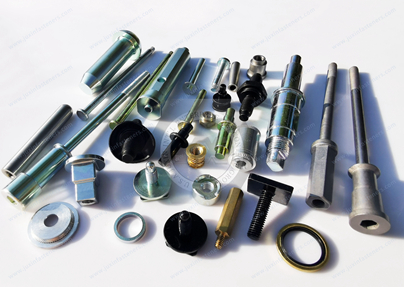 | 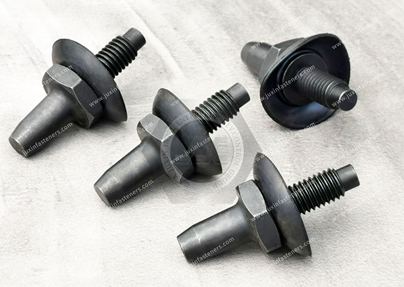 | 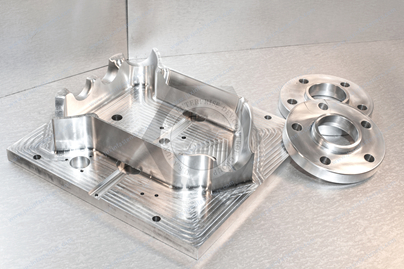 |
Technical methods of aluminum alloy parts processing:
1. Machining datum selection: The machining datum should be as consistent as possible with the design datum, assembly datum, and measurement datum, and the machining process should fully consider the parts' stability, positioning accuracy, and clamping reliability.
2. Rough machining: As the machining dimensional accuracy and surface roughness of some aluminum alloy parts do not quickly meet high precision requirements, some parts with complex shapes need to be rough machined before processing and cut in combination with the characteristics of aluminum alloy materials. The heat generated in this way will lead to cutting deformation, increase the error of part size in different degrees, and even lead to deformation of the workpiece. Therefore, milling and planing are used for the rough machining generally flat surfaces. At the same time, coolant is added to cool the workpiece to reduce the effect of cutting heat on machining accuracy.
3. Finishing machining: In the processing, high-speed cutting will produce a large amount of cutting heat; although the debris can take away most of the heat, the blade can still have a very high temperature due to the low melting point of aluminum alloy, the blade is often semi-melting so that the strength of the cutting point is affected by high temperature, easy to produce aluminum alloy parts in the process of forming bump defects. Therefore, in the finishing process, we usually choose the cutting fluid with good cooling performance, good lubrication performance, and low viscosity. In the lubrication tool, the cutting heat is taken away in a timely manner, the tool's temperature and parts processing surface are reduced, and the temperature deformation of the parts is reduced.
4. Reasonable choice of tools: Compared with ferrous metals, aluminum alloy materials produce relatively small cutting forces in the cutting process. You can use a more considerable cutting speed, but it is easy to form a chip tumor. The thermal conductivity of aluminum alloy is very high. Due to the high heat of debris and parts during the cutting process, the temperature of the cutting area is low, and the tool's durability is increased. Still, the rise in temperature of the part itself is faster and quickly causes deformation. Selecting suitable tool material, choosing a reasonable tool angle, and improving the surface roughness of the tool are very effective in reducing the cutting force and cutting heat.
5. heat treatment and cold treatment to solve the processing deformation: heat treatment methods to eliminate the processing stress of aluminum alloy materials are artificial timeliness, recrystallization annealing, etc. The simple structure of the parts process route is generally used: rough machining, manual just-in-time, and finishing. The process route of parts with complex structures generally uses rough machining, artificial promptness (heat treatment), semi-finishing, artificial promptness (heat treatment), and finishing. While arranging a manual just-in-time (heat treatment) process after roughing and semi-finishing, a stable heat treatment process can be set after completing the part to prevent small dimensional changes in part placement, installation, and use.
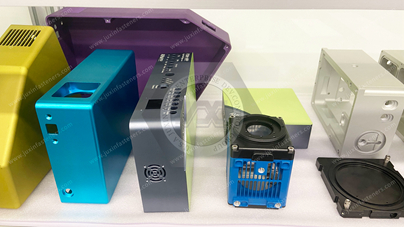 | 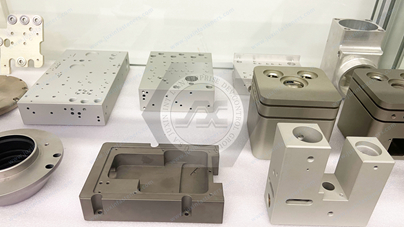 |
Process characteristics of aluminum parts processing
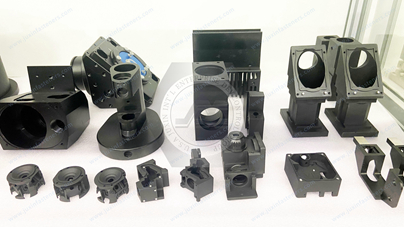 | 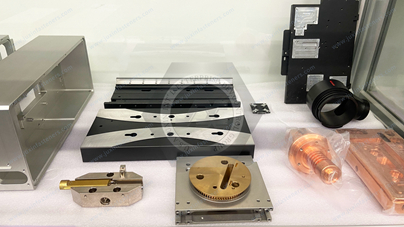 |
(1) can reduce the influence of residual stress on processing deformation. After rough machining is completed, heat treatment is recommended to remove the stress generated by the rough machining of the part to reduce the impact of stress on the quality of finishing.
(2) Improve machining accuracy and surface quality. After the separation of roughing and finishing, finishing is just a tiny machining allowance; machining stress and deformation are minor, which can significantly improve the quality of the parts.
(3) Improve production efficiency. Because rough machining only removes excess material, leaving enough margin for finishing, it does not consider the size and tolerance. To improve cutting efficiency, it effectively plays the performance of different machine tool models.
After the aluminum parts are cut, the metal organization in the machining table will be significantly changed. In addition, cutting motion can lead to more significant residual stresses. The material's residual stresses need to be fully released to reduce the part's deformation.
Contact Us
Tel.:
+86 020 8621 0320
+86 020 3121 6067
Technical Support:
Navigation
SEND INQUIREY